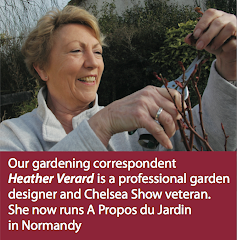yellow geraniums, blowsy Mimulus and plants for boggy spots
plus May “to do” list
It’s that time of year again – window boxes, hanging baskets and granite troughs are suddenly filled with an abundance of colour – Bacopa, Nemesia, Lobellia, Petunias etc. And of course, annual geraniums (or if we’re being pedantic, Pelargoniums). This year there are two new colours – ‘Apple Blossom’ and ‘Shocking Pink’ in the upright form, plus of course the rarely previously seen in France – yellow geraniums. The colour is pale primrose, the leaves are paler green than the norm and they look lovely mixed with bright blue lobellia.
For something quite different, there are big blowsy Mimulus (yellow with red spots) available as well as dainty Petunia ‘Million Bells’ that are smothered in little miniature flowers in shades of red, pink and yellow.
May is Lilac time, too. Single and double flowers are available in shades of white, lavender and
 purple. The beautiful Persian Lilac (Syringa persica) is a quite different shrub, though, with stunning lacy apple-green foliage and highly scented pink flowers. The trouble with the ordinary lilac (Syringa vulgaris) is that once the flowers have faded, it’s fairly boring – the foliage is large and matt. However, it makes a great vehicle for growing other plants through – clematis can romp up its stems and provide flowers through the summer. And if you have a really big lilac tree, try growing a rambling rose through it, to give colour and scent through June and July.
purple. The beautiful Persian Lilac (Syringa persica) is a quite different shrub, though, with stunning lacy apple-green foliage and highly scented pink flowers. The trouble with the ordinary lilac (Syringa vulgaris) is that once the flowers have faded, it’s fairly boring – the foliage is large and matt. However, it makes a great vehicle for growing other plants through – clematis can romp up its stems and provide flowers through the summer. And if you have a really big lilac tree, try growing a rambling rose through it, to give colour and scent through June and July.Damp and Boggy Spots
May is also a good month for the bog primrose – Primula florindae. Needless to say, this plant likes to have its feet in moist soil. It makes a clump of quite large leaves above which drooping heads of scented yellow flowers hang for weeks.
On the subject of damp or boggy soil, Astilbe and Aruncus are two wonderful perennials for just such awkward spots, as well of course as Hostas, several types of Iris, Rogersia, Ligularia and Gunnera.
For more substantial planting in wet soil, Cephalanthus is a must. This largely unknown shrub is commonly known as the ‘Button Bush’ – the white flowers resemble little tufts of cotton wool. It grows to just about 1.5 metres and really thrives with its feet in very wet ground. Then there’s a whole range of dogwoods (Cornus spp.) that enjoy wet soil. Cornus alba varieties have red stems in winter and C. stolonifera have yellow stems. And there’s one little oddity in this family – Cornus stolonifera ‘Kelsey’s Dwarf’ – that has both yellow and red stems on the same (much shorter) plant. Hard prune these dogwoods in late February to maintain the coloured stems – if you don’t, they will eventually revert to brown and offer no winter interest at all.
Trees to grow in boggy areas:
Taxodium distichum A deciduous conifer, Taxodium is commonly known as the Swamp Cypress and as its name suggests, it loves a really wet soil. One of my clients in England was beside herself with frustration at what to do about an area of garden that was totally waterlogged all year (they lived on the edge of the Barnes Wetlands). We planted a stand of three Taxodiums and within just a few months, the surrounding land was dry and the trees were flourishing.
Salix alba ‘Tristris’ (syn. Salix x chrysocoma), is the well known and popular weeping willow tree that equally, makes a good subject for wet soil. The advantage of a weeping willow is that the stems remain golden yellow in winter. But beware, it really does need a large garden, as it can grow to 20metres high and 25metres wide!
Betula nigra (River Birch) is also a good subject for wet ground and is quite different from the white-stemmed birches. This bark is pinky-grey and peeling and the leaves diamond-shaped with pale undersides.
Liquidamber styraciflua This Sweetgum is very popular in Normandy, where the soil conditions are perfect. A real aristocrat for autumn colour too, it has a good architectural shape and is suitable for the moderate to large garden. The bark is quite corky and the flower insignificant. Look out for the varieties L.s. ‘Worplesdon’ for wonderful autumn foliage and L.s. ‘Variegata’ which has white creamy margins on the grey green leaves.









